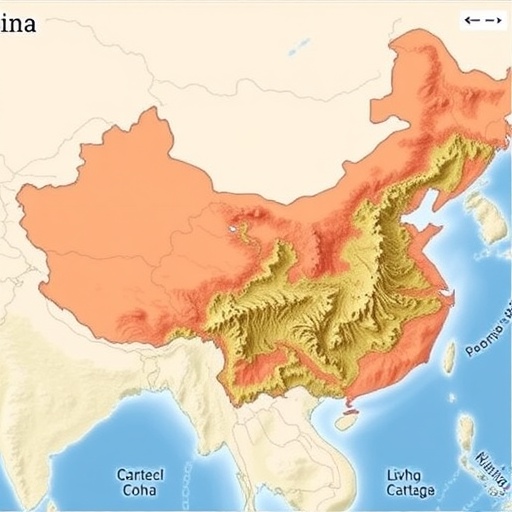In a groundbreaking study, researchers have unveiled significant insights into the geological history of the North China Craton, particularly focusing on the transition from an orogenic plateau to a thinning phase during the Mesozoic era. This shift is crucial in understanding the continent’s tectonic evolution and the underlying dynamics that have shaped its geological framework over millions of years.
Historically, the North China Craton, one of the Earth’s largest tectonic blocks, has been a subject of contention among geologists seeking to unravel its complex past. The area is characterized by a diverse range of geological formations, including ancient granite basement rocks, sedimentary cover, and volcanics, leading to diverse interpretations of its tectonic activities. The researchers designed their study to investigate the nuanced transitions that have occurred in this region, particularly during the Mesozoic period.
The team, led by notable geologists Chen, Zhou, and Xu, utilized advanced geophysical techniques and sedimentological analysis to trace the tectonic movements that defined this region. Their findings reveal that the once stable and elevated terrain of the North China Craton began to experience significant thinning, indicating a complex interplay of tectonic activities. This transition was marked by changes in stress regimes that may have resulted from significant geological forces operating at depth.
One of the primary facets of the study emphasizes the mechanisms driving the transition from orogenic plateau conditions to thinning. The researchers noted that this transformational phase was likely influenced by a combination of factors, including mantle dynamics and the application of extensional tectonics. The profound understanding of these forces opens avenues for further research into regional tectonics, not only within the North China Craton but also in other similar geological environments worldwide.
Furthermore, the study introduces a concept termed “dynamic topography,” which refers to the variations in the Earth’s surface elevation caused by dynamic processes in the mantle. The findings show a correlation between the thinning of the crust and alterations in mantle convection patterns that affect the elevation of the North China Craton. Understanding these patterns is vital for piecing together the region’s geological history and assessing potential future developments.
Critically, this research holds implications for understanding not just historical geology but also the potential for future geological risks, including seismic activities in the region. As the dynamics of the Earth’s crust continue to evolve, insights garnered from this study allow scientists to better predict and prepare for potential geological hazards. The researchers affirm that understanding the dynamics of the North China Craton is imperative for resource exploration and disaster preparedness in this historically rich area.
Moreover, the research highlights the role of magmatism in the transitioning phases of the North China Craton, suggesting that volcanic activity played a significant role in reshaping the landscape throughout the Mesozoic. The correlation between magmatism and tectonic activities provides a clearer understanding of the geological processes and helps clarify the chronology of events that led to the craton’s present form.
As the study delves deeper into the years of geological activity, it explores an arsenal of geological evidence that affirms the ongoing debate regarding the craton’s geological past. The research team approaches conflicting theories with measured caution, acknowledging the diversity of interpretations that have emerged over the decades. By situating their findings within the broader geological discourse, they offer a comprehensive perspective that may unify disparate views on the tectonic evolution of this vital area.
The broader implications of these findings extend beyond the realm of academic inquiry; they offer potential insights for various industries reliant on geological stability, such as mining and civil infrastructure. The dynamic interactions between geological formations can offer valuable resources, but they also necessitate an understanding of risks posed by geological instability. Therefore, the researchers’ findings serve as an essential foundation for harmonizing economic development with environmental safety.
This study also underscores the importance of interdisciplinary collaboration in geological research. By melding geological analysis with advanced geophysical tools, the research exemplifies how comprehensive approaches can illuminate complex subjects. The alignment of different scientific methodologies serves as a catalyst for innovative ideas within the geological sciences.
Importantly, the findings published in the journal “Commun Earth Environ” catalyze further inquiry into the dynamics of Earth’s crust under similar geological settings worldwide. This work paves the way for future studies to replicate methodologies and concepts, establishing a framework for understanding cratonic systems across different global contexts.
In summary, the research not only contributes significantly to the geological understanding of the North China Craton but also encourages a broader dialogue about cratonic dynamics on a global scale. The revelations regarding the transition from an orogenic plateau to thinning illustrate the ever-evolving nature of geological science, and how ongoing study is essential for deciphering Earth’s complex history. As the field progresses, it is hoped that such research will foster a more profound appreciation for the dynamic processes that shape our planet’s surface.
Understanding the delicate balance between geological history, current dynamics, and future implications is a remarkable endeavor that underscores the importance of continued scientific exploration. This research reaffirms that studying our planet is a deeply interconnected pursuit that brings together diverse scientific narratives, ultimately leading to a richer understanding of our Earth and its geological heritage.
Subject of Research: Geological transition dynamics of the Mesozoic North China Craton.
Article Title: Transition from orogenic plateau to thinning reveals mesozoic North China craton dynamics.
Article References: Chen, Y., Zhou, Z. & Xu, C. Transition from orogenic plateau to thinning reveals mesozoic North China craton dynamics. Commun Earth Environ 6, 791 (2025). https://doi.org/10.1038/s43247-025-02784-2
Image Credits: AI Generated
DOI: 10.1038/s43247-025-02784-2
Keywords: North China Craton, orogenic plateau, tectonics, Mesozoic, geological dynamics, dynamic topography, crustal thinning, mantle convection, seismicity, resource exploration, interdisciplinary collaboration.




